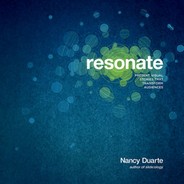
Find someone
as far away from
your twisted
environment as
possible to give
honest feedback.
182 Resonate
We’ve become a first-draft culture. Write an e-mail. Send.
Write a blog entry. Post. Write a presentation. Present.
The art of crafting and then recrafting something well is
disappearing in communications.
Host a Screening with Honest Critics
feedback for the screening may require you to go outside
of your organization.
Remove yourself from a sugar-sweet or dysfunctional
review environment. Instead, pull together a small group
that has a similar profile as your target audience. They
could be people in your industry like analysts, internal
employees, trusted customers, or a focus group. Choose
naysayers who will scrutinize, criticize, and challenge your
perspective. You want them to be brutally honest when
they tell you what they think.
Each screener should have a printout of the slides and
notes of your presentation so they can quickly jot down
thoughts on the words and the visuals. Run through the
entire presentation once and then revisit each section
carefully. A solid review meeting should last about three
times as long as the presentation itself. If your presenta-
tion is twenty minutes long, for example, each screening
should take an hour. If your presentation lasts an hour,
the screening should take three.
“The first draft of anything is shit.”
Ernest Hemingway
It’s easy for us to get attached to our own ideas, so it’s
good to have another set of eyes and ears to review them.
The best way to get feedback is to host a screening to
test your messages before you present. The screening
should filter out any meandering structure, obstructed
messages, and confusing language.
Keep an open mind and come to the screening knowing
that you will probably need to rework some percentage
of the communication that you labored over for so long.
No one ever hears during the first review, “I wouldn’t
change a thing.” Regardless of how relentlessly you
worked, there will be changes at this phase. The informa-
tion was created from your perspective. To the degree
you are receptive to feedback from others, you’ll be able
to refine the receptivity potential of your material for oth-
ers. The screening should influence and round out how
you deliver your presentation.
Conway’s Law states, “Any organization that designs a
system will inevitably produce a design whose structure
is a copy of the organization’s communication struc-
ture.” In other words, the quality of communication your
organization generates is limited to the quality of the
communication of the organization itself. For this reason,
a presentation’s quality will not exceed the quality of
the planning process that precedes it. Therefore, pull-
ing together a team who will give you honest, helpful
CH008.indd 182CH008.indd 182 8/16/10 6:17:28 PM8/16/10 6:17:28 PM

There's Always Room to Improve 183
CONCEITED CAPTAIN: Leader
engages late and forces team into
time-crunched, low-quality output.
POLITICAL PARANOIA: No one makes
progressive decisions out of fear for
their own destruction.
MESSAGE MAGIC: In the absence of a
strategy, imaginary messages become
the norm. (See page 199)
VACUUM VISIONARY: There’s no room
for alternative perspectives, and subject
matter experts have no seat at the table.
LACKEY LEADER: Indecisive leadership
and flattery-driven consensus stalls
strategy traction.
CUSTOMER COLD-SHOULDER: Self-
focused communication is valued more
highly than customer insight.
Give your test audience a safe environment to tell you what they really
think. Solicit feedback in a nondefensive way and let them challenge
all assumptions. Encourage them to tell you whether your presentation
genuinely kept their interest.
Don’t ignore your screeners’ insights or give “yeah, but…” or “if they really
knew…” excuses. Really listen to them and incorporate their insights. Then,
rework your material. Screening the presentation will remove any burrs that
would unintentionally snag or poke the audience with misunderstandings.
These negative organizational systems, illustrated below, limit the qual-
ity of your communication. If you work in any of these communication
environments, go outside your organization to get honest, constructive
feedback on your presentation.
CH008.indd 183CH008.indd 183 8/16/10 6:17:29 PM8/16/10 6:17:29 PM
..................Content has been hidden....................
You can't read the all page of ebook, please click here login for view all page.
